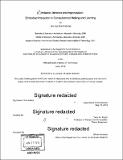[I³] imitation, iteration and improvisation : embodied interaction in computational making and learning
Author(s)
El-Zanfaly, Dina Ezz ElDin
DownloadFull printable version (28.54Mb)
Alternative title
Embodied interaction in computational making and learning
Other Contributors
Massachusetts Institute of Technology. Department of Architecture.
Advisor
Terry W. Knight.
Terms of use
Metadata
Show full item recordAbstract
Despite advances in digital design and fabrication technologies, creative design practices still follow Alberti's separation of the design phase from the construction phase. This separation causes a reliance on digital fabrication machines that pushes human agency to the periphery of the making process. The interfaces of these technologies and their linear process of production create cognitive and perceptual obstacles, making it difficult for non-experts to create and improvise independently. Design and the ability to make are often thought to be intuitive, yet significant research has suggested that intuition is developed through skilled practice, interaction with materials, tools, and machines. Existing pedagogical approaches to design focus on outcomes and instructors' feedback to the students, neglecting the importance of the tools and the process itself. How, then, do we learn to make something? What are the potential roles of computational tools, theories, and practices in understanding, describing, and enriching the making and learning process? What can we learn from machines, and what can machines learn from us? Finally, what do we learn from making? Here, I introduce l³, a computational making methodology that enables emerging designers and makers to improvise and create on their own. I call this method F for its three-layer operation of Imitation, Iteration and Improvisation. Drawing upon research from other fields, this methodology for human-machine making and learning is based on a recursive process of embodied, situated interaction between learners, machines, materials, and the things-in-the-making. I describe the continuous process of developing and testing 1³ through experiments I conducted during the teaching of three courses for graduate and undergraduate students. The qualitative research I conducted shows that through using the 1³ methodology, students develop their spatial reasoning and decision-making skills while at the same time learning to use digital technologies as design companions.
Description
Thesis: Ph. D. in Architecture: Design and Computation, Massachusetts Institute of Technology, Department of Architecture, 2018. Cataloged from PDF version of thesis. Includes bibliographical references (pages 122-127).
Date issued
2018Department
Massachusetts Institute of Technology. Department of ArchitecturePublisher
Massachusetts Institute of Technology
Keywords
Architecture.